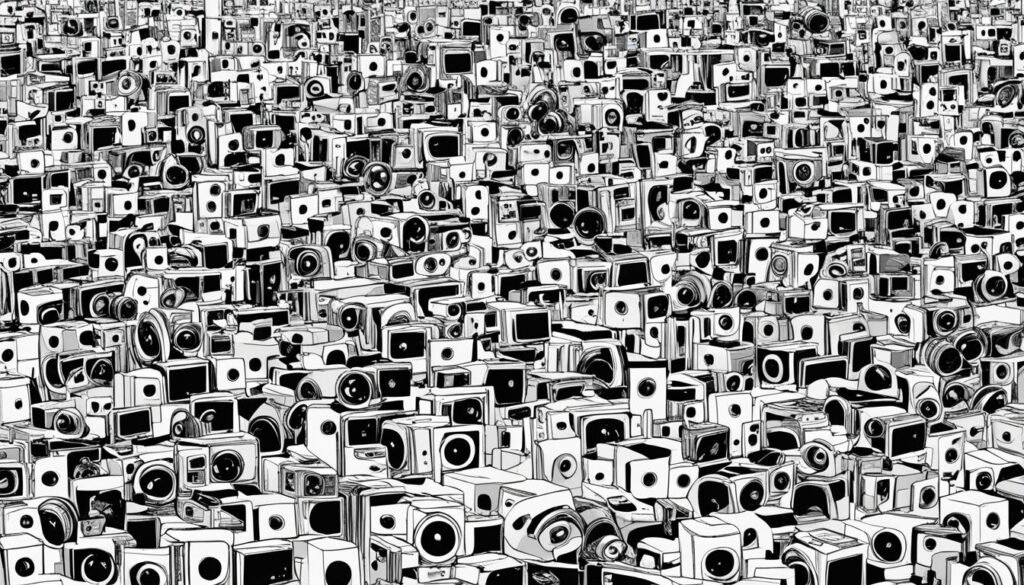Are you unknowingly being watched? In today’s digital age, hidden surveillance devices threaten our privacy. Bug detectors are now key security tools. They help protect our personal spaces from unwanted eyes and ears.
These devices find hidden surveillance like tiny microphones and secret cameras. As technology gets better, so does the way we’re watched without knowing. So, bug detectors are more important than ever for keeping us safe.
Bug detectors use advanced tech to look for radio signals, infrared, and magnetic fields. These signs might mean there’s a hidden device around. They’re a must-have for anyone wanting to keep their privacy safe at home or work.
We’ll dive into how bug detection works, its main features, and why it’s vital today. Keep reading to learn how to shield yourself from unwanted watching and keep your peace of mind.
Understanding Bug Detectors and Their Importance
Bug detectors are key in our digital lives. They help find hidden spy gear, keeping our privacy safe. With spy tech getting better, we need good ways to fight back.
What are bug detectors?
Bug detectors are tools made to spot hidden spy devices. They look for strange signals that could mean there’s a hidden camera, microphone, or tracker. They’re not for testing software or finding bugs in apps, but for finding real-life privacy threats.
Why are they crucial today?
Today, we’re more at risk of being watched without our okay. Bug detectors help keep our privacy safe. They give us confidence in places like meeting rooms, hotel rooms, or our cars. With tiny, cheap spy gadgets out there, having bug detectors is a must for keeping our privacy.
Common types of hidden surveillance devices
There are many kinds of hidden cameras, audio bugs, and GPS trackers out there. These can be super small and blend in with everyday things. Bug detectors aim to find these sneaky gadgets, helping us keep our privacy in a world full of spy tech.
The Evolution of Surveillance Technology
Surveillance technology has changed a lot over time. Early devices were simple audio bugs. Now, they can record video and gather lots of data. This growth has led to better bug detection technology to match the advanced surveillance tools.
The global Internet of Medical Things market was worth $48.7 billion in 2022. This shows how connected devices are becoming more common. Surveillance is also getting more advanced, making bug detection more important. Cybercrimes could cost $10.5 trillion by 2025, highlighting the need for strong detection systems.
Now, bug detectors have features like frequency scanning and signal strength measurement. These help find hidden devices better. Studies show RF algorithms can detect intrusions with up to 99.93% accuracy, beating other methods.
The radiation detection market is growing fast, showing the need for better surveillance and detection. It was worth $75.27 billion in 2023 and could hit $159.71 billion by 2031. This growth shows how surveillance and detection technologies are always getting better.
How Bug Detectors Work: Principles and Mechanisms
Bug detectors use various methods to find hidden surveillance devices. They scan for gadgets that might be spying on you. Let’s explore how they work.
RF Signal Detection
RF signal detection is crucial in bug detectors. They look for radio waves from bugs. These tools can spot hidden cameras or microphones sending data wirelessly.
By sweeping an area, they catch any odd signals. This means they can find bugs nearby.
Infrared Detection
Infrared detection searches for heat from devices. All gadgets produce warmth when on. Bug detectors with this feature can detect the heat from hidden cameras or recorders.
They show these hot spots, even if the device is hidden. This helps in finding bugs behind walls or objects.
Magnetic Field Detection
Magnetic field detection finds bugs that create electromagnetic fields. Many devices produce these fields when active. Bug detectors can sense these fields to locate hidden devices.
This method is great for finding wired bugs or those without radio signals.
Modern bug detectors combine these detection methods. Some top models use test automation for quick and precise scanning. By using RF signal detection, infrared detection, and magnetic field detection, these tools provide strong protection against hidden surveillance.
Key Features to Look for in a Quality Bug Detector
When picking a bug detector, some features are key for effective use. A wide detection range is at the top of the list. It lets you scan big areas fast, boosting your chances of spotting hidden devices.
Sensitivity adjustments are vital. They help you adjust the detector to catch even weak signals. Look for devices with various detection modes. These can help you identify different types of surveillance gear.
Signal strength indicators are very useful. They tell you how close you are to a bug. Audio alerts are another important feature. They let you know about detected signals without needing to watch the screen all the time.
Advanced models have more features. These might include showing frequencies and logging data. Some even work with smartphone apps for detailed analysis. Remember, the best bug detector should be easy to use and have advanced features.
Top Bug Detectors: Comparing Leading Models
Bug detectors vary to meet different needs and budgets. Let’s look at the options available in the market today.
Professional-grade detectors
Professional bug detectors are very sensitive and have advanced features. They can find a lot of frequencies and are used by security experts. KJB Security Products is a top brand for these tools, offering reliable devices for detailed surveillance detection.
Consumer-friendly options
For personal use, consumer bug detectors are easy to use and functional. Spy-Hawk makes devices that spot hidden cameras and microphones in homes or offices. These detectors are great for people who want to keep their privacy without needing to know a lot about technology.
Budget-friendly choices
Budget-friendly bug detectors offer basic detection at a low cost. Ysucau makes affordable detectors that can find common surveillance devices. They might not have as many features as professional models, but they still give peace of mind for those worried about privacy.
When picking a bug detector, think about what you need and where you’ll use it. Professional detectors give the best protection but are more expensive. Consumer detectors offer a good mix of price and features. Budget-friendly options provide basic security for those watching their spending.
Bug Detectors: Find Hidden Surveillance Devices
Bug detectors are key in finding hidden surveillance devices. They protect privacy in places like offices and hotel rooms. By using bug detection techniques, you can spot unauthorized monitoring gear.
Offices are often targeted by corporate spies. A detailed check with a bug detector can find hidden mics or cameras. Hotel rooms, seen as private, might also have surveillance. Travelers can use portable bug detectors to keep their privacy safe.
Cars are another spot where privacy matters a lot. Bug detectors can spot GPS trackers or listening devices without your knowledge. It’s important to understand how to read the detector’s signals. Sometimes, it might show false positives, so getting to know your device well is crucial.
Using bug detectors often is key to keeping your privacy. As surveillance tech gets better, so do the ways to detect bugs. Keeping up with the latest in bug detection helps fight against hidden surveillance.
Legal Considerations When Using Bug Detectors
Bug detector laws change from place to place. It’s key to know the privacy laws and surveillance rules before using these tools. The rules for personal and professional use are different.
In many places, having a bug detector for personal safety is okay. Yet, using them in some spots could be illegal. For instance, some places don’t let you record conversations without permission. This makes using bug detectors in work or public areas risky.
Privacy laws are important for bug detectors. They protect our right to privacy. They often stop unauthorized spying. It’s smart to check the local laws to stay out of trouble. Some places need a license for bug detectors, especially for work.
Rules on surveillance also affect bug detectors. These rules say what kind of monitoring is allowed. They might tell you where and how you can use bug detectors. Breaking these rules can lead to big fines or legal problems.
Before using a bug detector, talk to a lawyer. They can explain the laws in your area and help you follow them. The main aim is to keep your privacy safe without hurting others’ rights.
DIY Bug Detection: Tips and Techniques
Protecting your privacy can be done with DIY bug detection. You don’t need professional gear to start. Here are some easy ways to find hidden surveillance devices.
Visual Inspection Methods
Start by looking closely at your surroundings. Look for anything out of place or new. Check for strange outlets, odd smoke detectors, or devices you don’t recognize.
Also, inspect walls, ceilings, and furniture for any signs of tampering. This can help you spot hidden bugs.
Using Smartphone Detection Apps
Smartphone detection apps can also help. They use your phone’s sensors to detect signals from surveillance devices. These apps aren’t as precise as professional tools but are still useful.
Recognizing Signs of Surveillance
Know what surveillance signs to look for. Listen for odd sounds on your phone lines. Watch for strange interference on your devices and pay attention to your Wi-Fi network’s behavior.
These signs could mean there are bugs or surveillance in your area.
Keep in mind, DIY methods have limits. If you think there’s a big security issue, get help from a pro. Regular checks with these tips can keep your privacy safe and your mind at ease.
Bug Detectors vs. Other Security Measures
Bug detectors are key in the security world. They help find hidden cameras or microphones in your space. This makes them a great addition to other security tools.
CCTV systems watch over visible areas but miss hidden devices. Encryption software keeps digital info safe, but not from being heard in person. Bug detectors are perfect for finding these hidden threats.
Stopping surveillance needs a mix of methods. Locks and alarms keep out intruders, but they can’t stop someone from planting a bug. Bug detectors help by checking for these hidden devices.
Today, using many security tools is important. Bug detectors work with other devices to protect your privacy. Adding them to your security plan means you’re better protected at home or work.
Future Trends in Bug Detection Technology
The world of bug detection technology is changing fast, with AI and machine learning leading the way. These changes will change how we find and stop hidden cameras and microphones. We’ll soon have tools that can spot even the most hidden devices quickly and accurately.
One big trend is making detectors smaller. Soon, we’ll have tiny devices that fit in a pocket or purse. This will make it easier for people to keep their privacy safe anywhere they go. Also, bug detection will work with smart home systems, giving constant updates and alerts if something looks fishy.
AI is set to greatly improve surveillance detection. It will help detectors tell real threats from harmless signals. This means fewer false alarms and better bug detection. As these technologies get better, keeping your privacy safe will become easier and more reliable for everyone.


